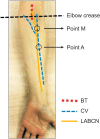Ultrasonographic Study of the Anatomical Relationship Between the Lateral Antebrachial Cutaneous Nerve and the Cephalic Vein
- PMID: 28758079
- PMCID: PMC5532347
- DOI: 10.5535/arm.2017.41.3.421
Ultrasonographic Study of the Anatomical Relationship Between the Lateral Antebrachial Cutaneous Nerve and the Cephalic Vein
Abstract
Objective: To define the anatomy of the lateral antebrachial cutaneous nerve (LABCN) and the cephalic vein (CV) in the anterior forearm region of living humans using ultrasonography for preventing LABCN injury during cephalic venipuncture.
Methods: Thirty forearms of 15 healthy volunteers were evaluated using ultrasonography to identify the point where the LABCN begins to contact with the CV, and the point where the LABCN separates from the CV. The LABCN pathway in the forearm in relation to a nerve conduction study was also evaluated.
Results: The LABCNs came in contact with the CV at a mean of 0.6±1.6 cm distal to the elbow crease, and separated from the CV at a mean of 7.0±3.4 cm distal to the elbow crease. The mean distance between the conventionally used recording points (point R) for the LABCN conduction study and the actual sonographic measured LABCN was 2.4±2.4 mm. LABCN usually presented laterally at the point R (83.3%).
Conclusion: The LABCN had close proximity to the CV in the proximal first quarter of the forearm. Cephalic venipuncture in this area should be avoided, and performed with caution if needed.
Keywords: Lateral antebrachial cutaneous nerve; Phlebotomy; Ultrasonography.
Conflict of interest statement
CONFLICT OF INTEREST: No potential conflict of interest relevant to this article was reported.
Figures


Similar articles
-
Sonography of the lateral antebrachial cutaneous nerve with magnetic resonance imaging and anatomic correlation.J Ultrasound Med. 2014 Aug;33(8):1475-83. doi: 10.7863/ultra.33.8.1475. J Ultrasound Med. 2014. PMID: 25063413
-
Computer-Assisted Surgical Anatomical Mapping of the Antebrachial Cutaneous Nerves: An Anatomical Study with a Proposition for Alternative, Cutaneous Nerve-Sparing Anterior Elbow Incisions.JB JS Open Access. 2023 May 15;8(2):e22.00048. doi: 10.2106/JBJS.OA.22.00048. eCollection 2023 Apr-Jun. JB JS Open Access. 2023. PMID: 37197699 Free PMC article.
-
Ultrasonographic findings of superficial radial nerve and cephalic vein.Ann Rehabil Med. 2014 Feb;38(1):52-6. doi: 10.5535/arm.2014.38.1.52. Epub 2014 Feb 25. Ann Rehabil Med. 2014. PMID: 24639926 Free PMC article.
-
Relation of Lateral Antebrachial Cutaneous Nerve to the Volar Approach to Distal Radius.J Hand Surg Asian Pac Vol. 2016 Feb;21(1):68-71. doi: 10.1142/S2424835516500107. J Hand Surg Asian Pac Vol. 2016. PMID: 27454506
-
Medial and lateral antebrachial cutaneous nerves: standardization of technique, reliability and age effect on healthy subjects.Arch Phys Med Rehabil. 1985 Sep;66(9):592-7. Arch Phys Med Rehabil. 1985. PMID: 4038023
Cited by
-
Anatomical analysis of antebrachial cutaneous nerve distribution pattern and its clinical implications for sensory reconstruction.PLoS One. 2019 Sep 11;14(9):e0222335. doi: 10.1371/journal.pone.0222335. eCollection 2019. PLoS One. 2019. PMID: 31509579 Free PMC article.
-
MRI findings of chronic distal tendon biceps reconstruction and associated post-operative findings.Skeletal Radiol. 2021 Jun;50(6):1095-1109. doi: 10.1007/s00256-020-03676-6. Epub 2020 Nov 24. Skeletal Radiol. 2021. PMID: 33236235 Review.
-
A review of main anatomical and sonographic features of subcutaneous nerve injuries related to orthopedic surgery.Skeletal Radiol. 2018 Aug;47(8):1051-1068. doi: 10.1007/s00256-018-2917-5. Epub 2018 Mar 16. Skeletal Radiol. 2018. PMID: 29549379 Review.
References
-
- Bassett FH, 3rd, Nunley JA. Compression of the musculocutaneous nerve at the elbow. J Bone Joint Surg Am. 1982;64:1050–1052. - PubMed
-
- Belzile E, Cloutier D. Entrapment of the lateral antebrachial cutaneous nerve exiting through the forearm fascia. J Hand Surg Am. 2001;26:64–67. - PubMed
-
- Brogan DM, Bishop AT, Spinner RJ, Shin AY. Lateral antebrachial cutaneous neuropathy following the long head of the biceps rupture. J Hand Surg Am. 2012;37:673–676. - PubMed
LinkOut - more resources
Full Text Sources
Other Literature Sources

